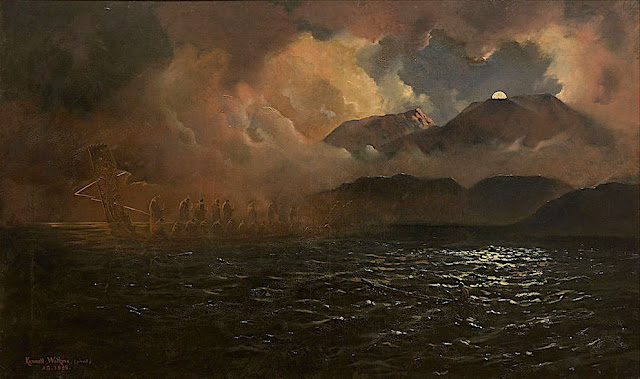
Mount Tarawera (1, 111m - 3,645ft)
New Zealand (North Island)
In The Phantom Canoe - A Legend of Lake Tarawera , oil on canvas Auckland Art Gallery
The Legend
One legend surrounding the 1886 eruption of Mount Tarawera is that of
the phantom canoe. Eleven days before the eruption, a boat full of
tourists returning from the Terraces saw what appeared to be a war canoe
approach their boat, only to disappear in the mist half a mile from
them. One of the witnesses was a clergyman, a local Maori man from the
Te Arawa iwi. Nobody around the lake owned such a war canoe, and nothing
like it had been seen on the lake for many years. It is possible that
the rise and fall of the lake level caused by pre eruption fissures had
freed a burial waka (canoe) from its resting place. Traditionally dead
chiefs were tied in an upright position. A number of letters have been
published from the tourists who experienced the event.
Though
skeptics maintained that it was a freak reflection seen on the mist,
tribal elders at Te Wairoa claimed that it was a waka wairua (spirit
canoe) and was a portent of doom. It has been suggested that the waka
was actually a freak wave on the water, caused by seismic activity below
the lake, but locals believe that a future eruption will be signaled by
the reappearance of the canoe.
The mountain and the lake
Mount Tarawera (1, 111m - 3,645ft)
is the volcano responsible for one of New Zealand's largest historic
eruptions. Located 24 kilometres southeast of Rotorua in the North
Island, it consists of a series of rhyolitic lava domes that were
fissured down the middle by an explosive basaltic eruption in 1886,
which killed an estimated 120 people. These fissures run for about 17
kilometres northeast-southwest.
The volcano's component domes
include Ruawahia Dome, Tarawera Dome and Wahanga Dome. It is surrounded
by several lakes, most of which were created or drastically altered by
the 1886 eruption. These lakes include Lakes Tarawera, Rotomahana,
Rerewhakaaitu, Okataina, Okareka, Tikitapu (Blue Lake) and Rotokakahi
(Green Lake). The Tarawera River runs northeastwards across the northern
flank of the mountain from Lake Tarawera.
Main eruptions
- 1315 :
Mount Tarawera erupted for the fist time on modern history. The ash
thrown from this event may have affected temperatures around the globe
and precipitated the Great Famine of 1315–17 in Europe.
- 1886
: Shortly after midnight on the morning of 10 June 1886, a series of
more than 30 increasingly strong earthquakes were felt in the Rotorua
area and an unusual sheet lightning display was observed from the
direction of Tarawera. At around 2:00 am a larger earthquake was felt
and followed by the sound of an explosion. By 2:30 am Mount Tarawera's
three peaks had erupted, blasting three distinct columns of smoke and
ash thousands of metres into the sky (see painting above). At around
3.30 am, the largest phase of the eruption commenced; vents at
Rotomahana produced a pyroclastic surge that destroyed several villages
within a 6 kilometre radius, and the Pink and White Terraces appeared to
be obliterated.
The eruption was heard clearly as far away as
Blenheim and the effects of the ash in the air were observed as far
south as Christchurch, over 800 km away. In Auckland the sound of the
eruption and the flashing sky was thought by some to be an attack by
Russian warships.
Although the official contemporary death toll was
153, exhaustive research by physicist Ron Keam only identified 108
people killed by the eruption. Much of the discrepancy was due to
misspelled names and other duplications. Allowing for some unnamed and
unknown victims, he estimated that the true death toll was 120 at most.
Some people claim that many more people died.
The eruption also
buried many Māori villages, including Te Wairoa which has now become a
tourist attraction (Buried Village of Te Wairoa) and the world-famous
Pink and White Terraces were lost. A small portion of the Pink Terraces
was rediscovered under Lake Rotomahana 125 years later. Approximately 2
cubic kilometres of tephra was erupted, more than Mount St. Helens ejected
in 1980. Many of the lakes surrounding the mountain had their shapes
and areas dramatically altered, especially the eventual enlargement of
Lake Rotomahana, the largest crater involved in the eruption, as it
re-filled with water.
The painter
Kennett Watkins
was born in India in 1847, the son of Major John Watkins and Martha Jane
Simons; he was Christened on 21 July 1847 in Ootacamund, Madras, India.
His father died some time before 1861. In the UK Census of 1861 he was
recorded in the household of his widowed grandmother Sarah Simons at 59
Marine Parade, Brighton, Sussex, England. Aged 13 and a scholar. Also in
the household was his widowed mother Martha, his three siblings Lydia,
Edward and John, 23 year old cousin Lieut. William Ker and two servants.
He was educated in England and, as an artist, in France and
Switzerland.
Kennett Watkins migrated from England to New Zealand.
He emigrated from England to New Zealand in 1873, where he married Clara
Eliza Alice Davis in 1876.
He was a photographer, painter of lndscapes (oil and waterolors) and teacher in Auckland.
He passed away in 1933 at age 86 and was buried in the Mercury Bay
Cemetery in Thames-Coromandel District, Waikato, New Zealand.
The
earliest auction registered for Kenneth Watkins pianitngs is in1992 for a
toal 57 worksoffered for sale of which 29 ( 51%) weresold. The highest
price recorded wis $ 136,450 for Maro family Canoeing on the Waokato
River.









-%20%20%20Mountain%20lanscapes%20%3F%20%20.jpg)







